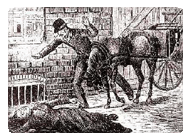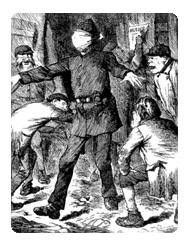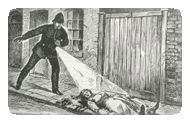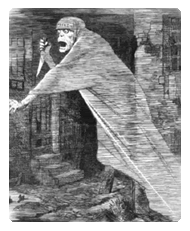Saturday, June 18, 2005
Case Not Closed
Stacie from EnglishSpace asks:
What did you think of Patricia Cornwell's book on Jack?
This is a tough one because of not only what the book propounds but because of behind-the-scenes activity as well. Ms. Cornwell did Ripper studies a service by providing millions of dollars for research into DNA analysis on the letters and on Walter Sickert. So, on that front, I would applaud the book even though I disagree with its conclusions. However, Ms. Cornwell falls into the same trap that many writers do when it comes to Jack: she starts with a suspect and makes all the facts and circumstantial evidence fit him. While she has given us unprecedented analysis of the letters, she has focused on her suspect to the detriment of other possibilities. I understand this, as her book is based on "solving" the crimes and looking at other suspects would not help her own sales and would diminish the power of her analysis. Therefore, we have no DNA on the victims or on other suspects to further the cause. Granted Ms. Cornwell can and did spend her money as she liked, but by ignoring other possibilities, she does her own cause no favors as far as serious researchers are concerned. Moreover, I perceived a huge arrogance in the fact that her acknowledgements contained only two resource books written about Jack the Ripper (Jack the Ripper: Letters from Hell and The Ultimate Jack the Ripper Sourcebook). Are we to understand that she never read any of the others, had no preconceived notions and started her whole investigation almost from scratch? I highly doubt it. One was basically a pictorial of the letters and the other is still not as comprehensive as Jack the Ripper A-to-Z; so, while worthwhile, these would not be the only books that a researcher would employ in writing about Jack, especially if you yourself are writing about the case for the first time. These books are ones a person conversant with the case already would use to aid them, not for an introduction to the case.
As for the book itself, there are two glaring problems with it
1) The letters. Ms. Cornwell takes the letters, keeps some and omits others, based on the "profile" of the killer she has subscribed to and that Sickert fits. Therefore, she believes she alone can say which letters are "fake" and which are "authentic." Also, Cornwell dismisses the possibility that ALL of the letters are hoaxes, something that is dangerous to do since it can be argued that they were all written by publicity-seeking crackpots or genuinely disturbed individuals. One need only think of the Yorkshire Ripper tape to find an instance where the killer and the person taunting the authorities proved to be separate people.
2)Fistula. I am no doctor and know next to nothing about fistula, its causes or manifestations. But I do know enough that when a medical report states that a person has a fistula yet does NOT state exactly where it is located on the sufferer's body, one cannot just assume it is in a particular place because that would happen to bolster a theory. Ms. Cornwell "proposes" that the fistula, or "hole," was in Sickert's penis. She bases this on a comment by Sickert's nephew, yet can find no confirmation for this. In fact, she writes that "In the nineteenth century, fistulas of the anus, rectum, and vagina were so common that St. Mark's Hospital in London was dedicated to treating them. There are no references to fistulas of the penis in the medical literature I consulted, but the term may have been loosely used to describe penile anomilies such as the one Sickert suffered from" (Portrait of a Killer: Jack the Ripper: Case Closed 63). Here, Cornwell goes from proving that fistula of the penis didn't exist anywhere she could find in medical records to stating as fact that Sickert suffered from just that type of malady. Specious at best. It wouldn't be such a glaring leap if it was not the basis of her theory: Sickert, according to Ms. Cornwell, develops his hatred of women, especially those who trade sex for money, because of his inability/occasional inability to have sex due to the fistula. Without this fistula, Cornwell's motive for Sickert is nonexistent.
The rest of the book is a tortuous exercise in using railway timetables and riding/walking distances to prove that Sickert could have gotten back to London from wherever he was staying in order to commit the crimes; either this or Ms. Cornwell says that Sickert and/or others were lying when it was said in correspondence where Sickert was during a particular murder. This is the problem with public figures and naming them as Ripper candidates; usually, there are records to prove where they were on some occasions. For instance, Prince Eddy, during one of the murders, was attending his father's birthday party in Balmoral, I believe. This is in the court records. Yet conspiracy-lovers would just say that the records had been doctored.
Overall, her book is a breezy summer read and enjoyable as hypothesis. Ms. Cornwell speaks clearly and concisely about Victorian attitudes toward sex and mentions how women were forced into lives of prostitution because of the Catch-22 situation of not being trained for employment yet forced to provide themselves and their children a living. But the book's theory on Sickert shouldn't be taken seriously-and that's a shame considering the amount of work and money she evidently put into it.
If you're interested, books that explore men and women during the 19th Century and the problems encountered due to Victorian sexual mores include:
The Other Victorians by Steven Marcus
City of Dreadful Delight by Judith Walkowitz
Crimes of Outrage by Shani D'Cruze
What did you think of Patricia Cornwell's book on Jack?
This is a tough one because of not only what the book propounds but because of behind-the-scenes activity as well. Ms. Cornwell did Ripper studies a service by providing millions of dollars for research into DNA analysis on the letters and on Walter Sickert. So, on that front, I would applaud the book even though I disagree with its conclusions. However, Ms. Cornwell falls into the same trap that many writers do when it comes to Jack: she starts with a suspect and makes all the facts and circumstantial evidence fit him. While she has given us unprecedented analysis of the letters, she has focused on her suspect to the detriment of other possibilities. I understand this, as her book is based on "solving" the crimes and looking at other suspects would not help her own sales and would diminish the power of her analysis. Therefore, we have no DNA on the victims or on other suspects to further the cause. Granted Ms. Cornwell can and did spend her money as she liked, but by ignoring other possibilities, she does her own cause no favors as far as serious researchers are concerned. Moreover, I perceived a huge arrogance in the fact that her acknowledgements contained only two resource books written about Jack the Ripper (Jack the Ripper: Letters from Hell and The Ultimate Jack the Ripper Sourcebook). Are we to understand that she never read any of the others, had no preconceived notions and started her whole investigation almost from scratch? I highly doubt it. One was basically a pictorial of the letters and the other is still not as comprehensive as Jack the Ripper A-to-Z; so, while worthwhile, these would not be the only books that a researcher would employ in writing about Jack, especially if you yourself are writing about the case for the first time. These books are ones a person conversant with the case already would use to aid them, not for an introduction to the case.
As for the book itself, there are two glaring problems with it
1) The letters. Ms. Cornwell takes the letters, keeps some and omits others, based on the "profile" of the killer she has subscribed to and that Sickert fits. Therefore, she believes she alone can say which letters are "fake" and which are "authentic." Also, Cornwell dismisses the possibility that ALL of the letters are hoaxes, something that is dangerous to do since it can be argued that they were all written by publicity-seeking crackpots or genuinely disturbed individuals. One need only think of the Yorkshire Ripper tape to find an instance where the killer and the person taunting the authorities proved to be separate people.
2)Fistula. I am no doctor and know next to nothing about fistula, its causes or manifestations. But I do know enough that when a medical report states that a person has a fistula yet does NOT state exactly where it is located on the sufferer's body, one cannot just assume it is in a particular place because that would happen to bolster a theory. Ms. Cornwell "proposes" that the fistula, or "hole," was in Sickert's penis. She bases this on a comment by Sickert's nephew, yet can find no confirmation for this. In fact, she writes that "In the nineteenth century, fistulas of the anus, rectum, and vagina were so common that St. Mark's Hospital in London was dedicated to treating them. There are no references to fistulas of the penis in the medical literature I consulted, but the term may have been loosely used to describe penile anomilies such as the one Sickert suffered from" (Portrait of a Killer: Jack the Ripper: Case Closed 63). Here, Cornwell goes from proving that fistula of the penis didn't exist anywhere she could find in medical records to stating as fact that Sickert suffered from just that type of malady. Specious at best. It wouldn't be such a glaring leap if it was not the basis of her theory: Sickert, according to Ms. Cornwell, develops his hatred of women, especially those who trade sex for money, because of his inability/occasional inability to have sex due to the fistula. Without this fistula, Cornwell's motive for Sickert is nonexistent.
The rest of the book is a tortuous exercise in using railway timetables and riding/walking distances to prove that Sickert could have gotten back to London from wherever he was staying in order to commit the crimes; either this or Ms. Cornwell says that Sickert and/or others were lying when it was said in correspondence where Sickert was during a particular murder. This is the problem with public figures and naming them as Ripper candidates; usually, there are records to prove where they were on some occasions. For instance, Prince Eddy, during one of the murders, was attending his father's birthday party in Balmoral, I believe. This is in the court records. Yet conspiracy-lovers would just say that the records had been doctored.
Overall, her book is a breezy summer read and enjoyable as hypothesis. Ms. Cornwell speaks clearly and concisely about Victorian attitudes toward sex and mentions how women were forced into lives of prostitution because of the Catch-22 situation of not being trained for employment yet forced to provide themselves and their children a living. But the book's theory on Sickert shouldn't be taken seriously-and that's a shame considering the amount of work and money she evidently put into it.
If you're interested, books that explore men and women during the 19th Century and the problems encountered due to Victorian sexual mores include:
The Other Victorians by Steven Marcus
City of Dreadful Delight by Judith Walkowitz
Crimes of Outrage by Shani D'Cruze
















"Specious" is such a great word!
The Prince Eddy alibi doesn't hold up in my view because everyone knows if you have money and know "some guy from a pub" you can always have work done at your behest.
Nevertheless, I stand by my theory (totally unfounded) that JTR was a woman. We're much meaner than people give us credit for.
I read Patricia Cornwell's book a long time ago and can't really remember all the facts. One thing that did bug me though was here reasoning. She would argue one point, then accept taht point as fact and use it to justify her next argument. Not good detection if you ask me! The whole book was based upon suposition after suposition. I love her fiction, but her investigative journalism leaves a lot to be desired!
Exactly. It's the difference between, as the Ripper Lady says at her website (see front page of my blog for link), "inductive and deductive reasoning." Cornwell starts with a supposition, then uses that to "prove" her next supposition as if it were fact. Case in point: Sickert had a fistula of the penis, therefore he was impotent, therefore he hated women. The very first part is not proven, so how can you accept the rest as factual?
Post a Comment
<< Home